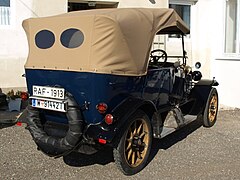Reichenberger automobile factory
| Reichenberger Automobile Factory (RAF) | |
|---|---|
| legal form | GmbH |
| founding | 1907 |
| Reason for dissolution | Merger with Laurin & Klement |
| Seat | Rosenthal near Reichenberg , Austria-Hungary |
| management |
|
| Branch | Automobile manufacturer |
The Reichenberger Automobil Fabrik (RAF) was a vehicle manufacturer from Austria-Hungary .
Company history
The textile manufacturer and racing driver Theodor Freiherr von Liebieg, a grandson of Johann Liebieg , founded the company in June 1907 together with Oscar von Klinger and Alfred Ginskey in Rosenthal near Reichenberg .
One of the first RAF cars was the Model T with a 4.5 liter four-cylinder engine and 30 hp. It already had a four-wheel brake and was presented at the Prague Motor Show in 1908. This car was given expensive bodies. There was also a version with a two-cylinder engine .
This was followed in 1910 by the H 10 model, also with a four-cylinder engine, but with a displacement of 5.3 liters and 45 hp. This vehicle was equipped with four independent brakes - two foot brakes, which served as gear and rear brakes, a normal handbrake and the mountain support that was common at the time . The top speed was 90 km / h.
At the same time the FW 25 was built, a 3.05 liter delivery van. The 14/18 followed in 1910. In this vehicle, the engine, clutch and transmission were mounted on a subframe that could be removed from the chassis very quickly for repair work.
The C 25 with 5.7 liter displacement and the 28/32 with 3.5 liter engine were developed under the leadership of the then well-known designer Paul Henze. Both were very expensive cars. Since these cars could only be sold in small numbers, the Hansa 6/14 PS and the Hansa 10/22 PS were manufactured under license by the Vareler Hansa-Werke .
Since 1908 there has also been a 4.5 liter truck. In this vehicle, the engine was installed under the driver's seat.
RAF also had a licensing agreement with the Daimler Motor Company in Coventry to build the Knight engines with valve control . In 1912 the LK 1 was built with a Knight engine and an output of 35 hp. Knight engines were also supplied to Puch in Graz by RAF .
When the decline of the RAF company became apparent in 1912, it merged with Laurin & Klement in the same year . RAF existed until the outbreak of the First World War and during this time two new models were developed with the 18/50 HP and the 13/40 HP, both with Knight engines. Many of Laurin & Klement's designs were based on earlier RAF designs.
photos
literature
- Harald H. Linz, Halwart Schrader : The International Automobile Encyclopedia . United Soft Media Verlag, Munich 2008, ISBN 978-3-8032-9876-8 .
- Automobile and motorcycle chronicle 2/1978
Web links
Individual evidence
- ^ GTÜ Society for Technical Monitoring
- ↑ Notes on Liebieg
- ↑ Harald H. Linz, Halwart Schrader : The International Automobile Encyclopedia . United Soft Media Verlag, Munich 2008, ISBN 978-3-8032-9876-8 .




